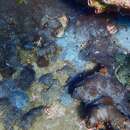fi
nimet breadcrumb-navigoinnissa


Plesiastrea versipora is an encrusting coral found in the Indian and Pacific Oceans.[3] It is of interest because of its ability to thrive in both tropical and temperate environments, and to grow massive.[4]
Existing massive colonies of P. versipora can be long lived, and so analysis of their internal composition allows deducing the climatic records of past decades and centuries, at localities where the corals grow.[3] Being the only coral genus in temperate waters that is capable of growing massive (up to a metre in thickness), P. versipora is a valuable indicator of climatic records of temperate seas.[3]
Plesiastrea versipora is also a model for communication between corals and their zooxanthellae. The substances that communicate to the symbiont are host-generated soluble compounds which can either signal the release of photosynthetic products (mainly glycerol) by the zooxanthellae,[5] or can inhibit photosynthesis.[6][7] This phenomenon may potentially be generalised to other coral genera, as identical Symbiodinium strains often occur in several coral host genera. P. versipora is the type host for a newly described minor symbiont Chromera velia,[8] which is present in small numbers in a host P. versipora coral colony, compared to the dominant Symbiodinium which is present in large numbers, to the point where C. velia cells may be barely detectable in the host except by culturing.
The host P. versipora reproduces sexually, with larvae obtaining symbiotic algae from the environment,[9] though anecdotal evidence shows some symbionts may also be a transmitted via the eggs,[10] indicating transmission may be mixed in this host species.
The species adopts a range of colours, being host pigments that protect the coral from ultraviolet radiation.[11][12] Colonies often occur close to one another, and contact one another. The range of colour morphs of P. versipora is broad and so it is very often obvious by their colours where one colony begins and another ends.
Plesiastrea versipora is an encrusting coral found in the Indian and Pacific Oceans. It is of interest because of its ability to thrive in both tropical and temperate environments, and to grow massive.
Existing massive colonies of P. versipora can be long lived, and so analysis of their internal composition allows deducing the climatic records of past decades and centuries, at localities where the corals grow. Being the only coral genus in temperate waters that is capable of growing massive (up to a metre in thickness), P. versipora is a valuable indicator of climatic records of temperate seas.
Plesiastrea versipora is also a model for communication between corals and their zooxanthellae. The substances that communicate to the symbiont are host-generated soluble compounds which can either signal the release of photosynthetic products (mainly glycerol) by the zooxanthellae, or can inhibit photosynthesis. This phenomenon may potentially be generalised to other coral genera, as identical Symbiodinium strains often occur in several coral host genera. P. versipora is the type host for a newly described minor symbiont Chromera velia, which is present in small numbers in a host P. versipora coral colony, compared to the dominant Symbiodinium which is present in large numbers, to the point where C. velia cells may be barely detectable in the host except by culturing.
The host P. versipora reproduces sexually, with larvae obtaining symbiotic algae from the environment, though anecdotal evidence shows some symbionts may also be a transmitted via the eggs, indicating transmission may be mixed in this host species.
The species adopts a range of colours, being host pigments that protect the coral from ultraviolet radiation. Colonies often occur close to one another, and contact one another. The range of colour morphs of P. versipora is broad and so it is very often obvious by their colours where one colony begins and another ends.
Plesiastrea versipora est une espèce de corail scléractiniaire à la taxinomie encore instable (non classé pour WoRMS et dans la famille des Faviidae pour ITIS). C'est la seule espèce du genre Plesiastrea.
Plesiastrea versipora is een rifkoralensoort,de plaats in een familie is onzeker.[2] De wetenschappelijke naam van de soort is voor het eerst geldig gepubliceerd in 1816 door Lamarck. De soort staat op de Rode Lijst van de IUCN geklasseerd als 'niet bedreigd'.[1]
Bronnen, noten en/of referentiesPlesiastrea versipora là một loài san hô trong họ Faviidae. Loài này được Lamarck mô tả khoa học năm 1816.
Plesiastrea versipora là một loài san hô trong họ Faviidae. Loài này được Lamarck mô tả khoa học năm 1816.